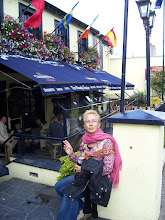
The Book of Kells was written around the year 800 AD. It contains a richly decorated copy of the four gospels in a latin text based on the Vulgate edition. It was transcribed by Celtic monks.
In all, there are 340 folios.

The script is embellished by the elaboration of key words and phrases and by an endlessly inventive range of decorated initials and interlinear drawings. Originally a single volume, it was rebound in four volumes in 1953 for conservation reasons.
It is a masterwork of Western calligraphy and represents the pinnacle of Insular illumination. It is also widely regarded as Ireland's finest national treasure.
The decoration combines traditional Christian iconography with the ornate swirling motifs typical of Insular art.
The manuscript takes its name from the abbey in Kells that was its home for centuries. Today it is on permanent display at the library of Trinity College in Dublin, Ireland. The library usually displays two of the current four volumes at a time, one showing a major illustration and the other showing typical text pages.





.jpg)

.jpg)